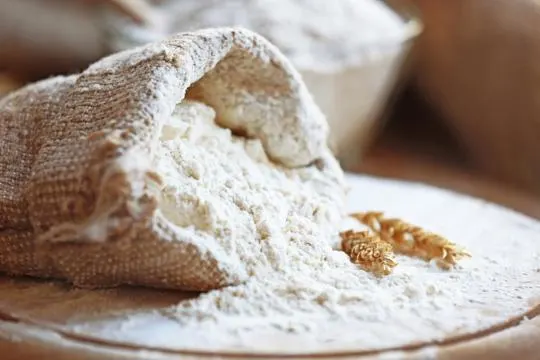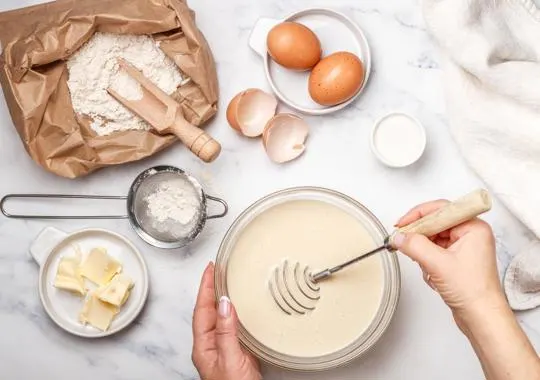Summary of key points
The main difference between baking mix and flour is in their ingredients and intended use. Baking mix is a pre-made mixture of flour, leavening agents, and other ingredients such as sugar or salt that can be used to make various baked goods with minimal effort. Flour is a single ingredient made from grinding grains or nuts into a powder.
In terms of versatility, flour can be used in a variety of recipes and is available in different types such as all-purpose, whole wheat, and gluten-free. Baking mix is typically only used for specific baked goods.
In terms of nutrition, flour may be a healthier option as baking mix often contains added sugars and preservatives. However, both can be enjoyed in moderation as part of a balanced diet.
It’s important to read ingredient labels and choose the option that best fits your dietary needs and preferences when cooking or baking.
Ever tried making a cake and it turned out less “wow” and more “oh wow”? We’ve been there. The secret might just lie in choosing between baking mix and flour. These aren’t the same beast.
Baking mix comes with some friends – baking powder, salt, sometimes sugar. Flour? It’s the lone wolf. One’s ready to party straight out the bag; the other needs you to invite the guests.
We remember our first baking fail. It was supposed to be a simple cake. Ended up a pancake. Lesson learned.
Knowing which to use can save your dessert. And your dignity.
What is Baking Mix?

Baking mix is a game-changer. It packs all the dry ingredients – like flour, leavening agents, sugar, and flavorings – into one convenient product.
Plus, it’s so simple. With baking mix, you can make pancakes, biscuits, muffins and more with just a few steps.
One great thing about baking mix is that it saves time.
All the dry ingredients are pre-measured, so you don’t have to measure and mix them yourself.
This way, you get consistent results each time you bake.
Baking mix also offers tons of convenience.
You don’t have to buy multiple bags of ingredients for various recipes.
One box of baking mix is enough.
Plus, there are different variations available – like chocolate chip pancake and blueberry muffin mix – so you can be creative.
In short, baking mix is great for home bakers who want to streamline their process and make delicious treats.
Give it a try and see how it can transform your next batch of baked goods.
What is Flour?

Flour is essential for baking. It’s made by grinding grains like wheat or rice into a fine powder.
This powder is included in doughs and batters, and it helps bind other ingredients together.
It also absorbs liquids, giving baked goods structure and a soft texture.
From bread to cookies, flour is the foundation for many treats.
Different flours have different characteristics.
All-purpose flour is versatile and has enough gluten to make baked goods elastic, but still fluffy.
Cake flour has a low protein content, making cakes tender.
Whole wheat flour has more nutrients, like the germ and bran.
And gluten-free alternatives, such as rice flour or almond flour, have their own flavors and textures.
Differences Between Baking Mix and Flour

Baking mix and flour appear similar, but have differences.
Composition and Ingredients
Baking mix and flour – not the same. Baking mix includes flour plus leavening, sugar and flavorings.
Plain flour is just ground grains. Mix saves time and effort for those who want quick baking.
So, different compositions make baking mix and flour distinct in terms of convenience.
Leavening Agents
Leavening agents are must-haves for baking. They help the dough and batter rise, making the end result light and fluffy.
These agents work by releasing gases.
Here are 6 common ones:
- Baking powder – a combo of baking soda, cream of tartar, and maybe cornstarch. Used when there are no acidic ingredients.
- Baking soda – aka sodium bicarbonate. Reacts with sour stuff like buttermilk or lemon juice to produce carbon dioxide.
- Yeast – a living organism that eats sugar and makes carbon dioxide as a waste product. Used in bread-making.
- Sourdough starter – a mix of yeast and lactobacilli that ferments flour and water. Releases carbon dioxide.
- Whipping agents – used for desserts like mousse or whipped cream. Incorporate air through mechanical action.
- Air – whisking or beating the batter can add air. Creates a lighter texture when baked.
Plus, there are niche options like ammonium carbonate and potassium bicarbonate.
Each agent has different properties based on things like temperature and moisture.
It’s important to understand leavening agents.
The right one can make a big difference in the final outcome.
Quick breads may need baking powder, while artisanal bread-making may use yeast.
Versatility in Baking
The secret to great baking? Versatility.
It’s the ability to mix and match ingredients, techniques, and flavors that makes a baker stand out.
Baking is a precise art requiring knowledge of ingredients and mixing methods.
A baking mix is a pre-mixed combination of flour, sugar, leavening agents, and flavorings.
It simplifies the process and ensures consistent results.
Plain flour, on the other hand, gives bakers more control over their creations.
They can customize flavors, textures, and shapes to suit their desired outcome.
Using plain flour allows for experimentation and creativity.
There are endless possibilities when it comes to crafting delicious baked goods.
Nutritional Content
The nutrition of baking mix and flour differ greatly.
Baking mix is pre-made and often contains flour plus other elements like sugar, baking powder and salt.
This means the nutrition of the mix will vary with brand and type.
Flour is just ground grains and is mainly carbs, protein and tiny amounts of vitamins and minerals.
No added sugar or other stuff like the mix.
So while both baking mix and flour are nutritious, you must think of their different structures when choosing your diet.
Similarities Between Baking Mix and Flour

Baking mix and flour differ in their purpose, yet also share some similarities.
One? They can both be used for a variety of recipes.
From cookies to cakes, and bread too, baking mix and flour can provide the essential base.
Plus, they both add structure. Gluten, a protein, gives dough its elasticity and causes it to rise.
This structure is crucial for getting the right texture.
Baking mix usually contains extra ingredients like leavening agents or flavorings.
Nevertheless, both baking mix and flour are great for creating tasty treats.
Customize your flavors and add-ins with either one.
Common Uses of Baking Mix and Flour
Baking mix and flour are staples in the culinary world.
They have unique properties, making them essential for various recipes.
Baking mix is a combination of dry ingredients.
It consists of flour, baking powder, salt, and sometimes sugar.
It’s great for making pancakes, waffles, biscuits, muffins, and quick breads quickly and easily.
Baking mix has pre-mixed leavening agents and seasonings, making measuring and mixing multiple ingredients unnecessary.
On the other hand, flour is made from grinding various grains or legumes.
It is incredibly versatile and is the base of many recipes.
Types of flour include all-purpose, cake, bread, and whole wheat.
Each type has different gluten content and protein levels, making it suitable for different uses.
Flour is more flexible than baking mix.
You can adjust the amount of leavening agents or try alternative grains or gluten-free options with plain flour.
Conclusion
Ultimately, the debate between baking mixes versus flour comes down to individual preference.
Baking mixes are convenient and easy to find, but flour is still a favorite due to its timelessness and traditional value in recipes.
Plus, flour provides more texture and flavor complexity that some would argue trumps a baking mix.
While both offer their own unique benefits, bakers should consider precedence factors such as cost, ease of use, and availability when choosing between baking mixes or flour for their baking needs.
All in all, there is no wrong selection when it comes to making the decision—both ingredients make phenomenal final products.
Don’t be afraid to experiment with different combinations until you find your own personal favorite; after all, variety is what makes baking so exciting.

Leave a comment